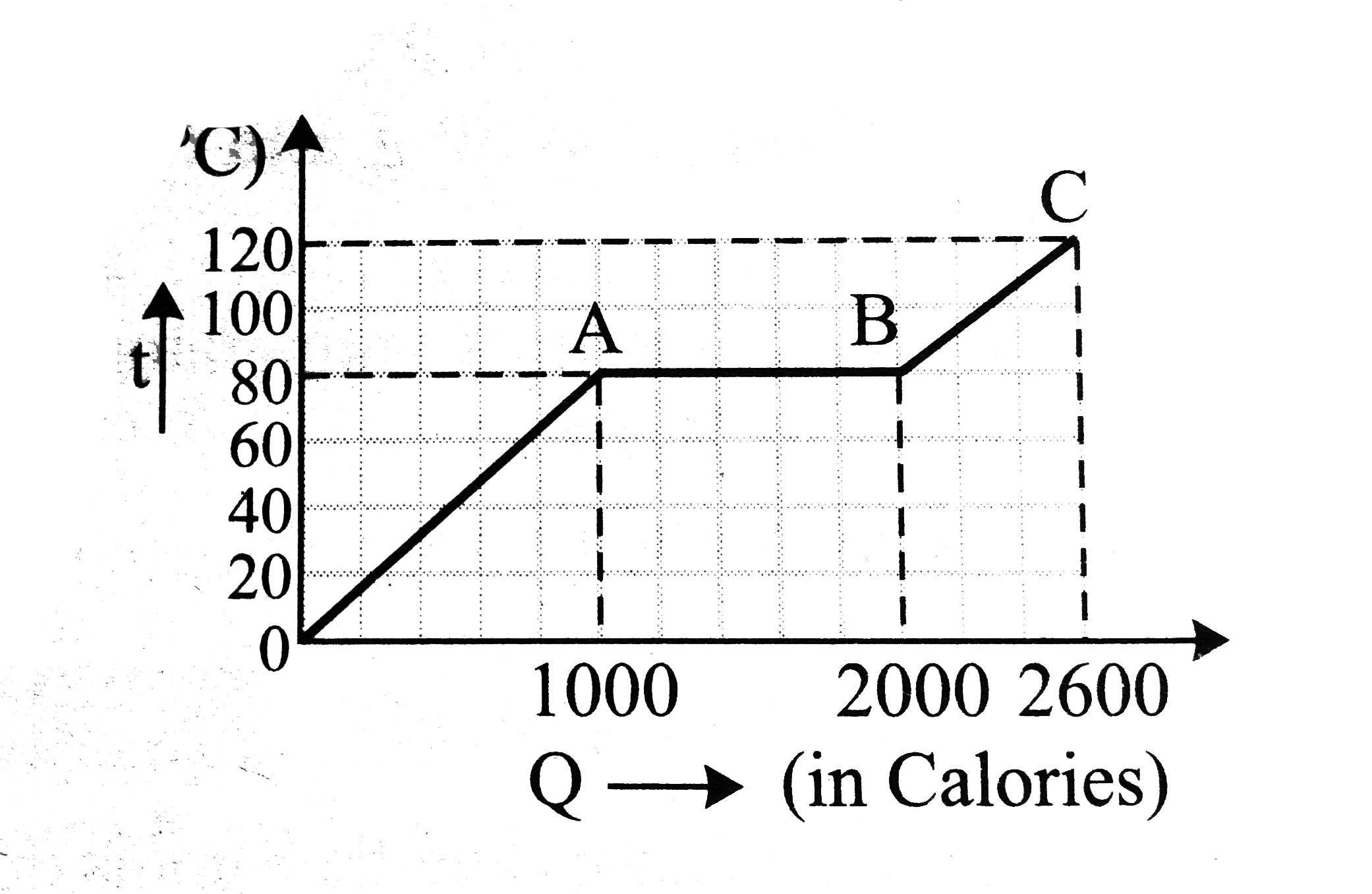A substance is in the solid from at 0∘C. The amount of heat added to this substance and its temperature is plotted in the graph . The specific heat capacity of the solid substance is 0.5cal//g∘C.
_E01_233_Q01.png)
The mass of the substance is -Solution in Gujrati
6g
12g
3g
Can't be calculated
The correct Answer is:A
450=m(0.5)(150)⇒m=6g
Topper's Solved these Questions
- GEOMETRICAL OPTICSBOOK - ALLEN CHAPTER - GEOMETRICAL OPTICSEXERCISE - EXERCISE - 04 (A)
48 Videos
- GEOMETRICAL OPTICSBOOK - ALLEN CHAPTER - GEOMETRICAL OPTICSEXERCISE - EXERCISE - 04 (B)
15 Videos
- GEOMETRICAL OPTICSBOOK - ALLEN CHAPTER - GEOMETRICAL OPTICSEXERCISE - ASSERTION-REASON
40 Videos
- CURRENT ELECTRICITYBOOK - ALLEN CHAPTER - CURRENT ELECTRICITYEXERCISE - EX.II
66 Videos
- GRAVITATIONBOOK - ALLEN CHAPTER - GRAVITATIONEXERCISE - EXERCISE 4
9 Videos
Similar Questions
Two rods each of length L2 and coefficient of linear expansion α2 each are connected freely to a third rod of length L1 and coefficient of expansion α1 to form an isoscles triangle. The arrangement is supported on a knife-edge at the midpoint of L1 which is horizontal. what relation must exist between L1 and L2 so that the apex of the isoscles triangle is to remain at a constant height from the knife edge as the temperature changes ?
View SolutionThe rectangular box shown in Fig has partition which can slide without friction along the length of the box. Initially each of the two chambers of the box has one mole of a mono-atomic ideal gas (λ=5/3) at a pressure P0, volume V0 and temperature T0. The chamber on the left is slowly heated by an electric heater. The walls of the box and the lead wires of the heater is negligible. The gas in the left chamber expands pushing the partition until the final pressure in both chambers becomes 243P0/32. Determine (i) the final temperature of the gas in each chamber and (ii) the work done by the gas in the right chamber.

View SolutionStatement-1: A real gas behaves as an ideal gas at high temperature and low pressure .
Statement-2: Liquid state of an ideal gas is impossible.
View SolutionIn the Bohr's model of hy drogen atom, the electron moves around the nucleus in a circular orbit of radius 5×10−11m. Its time period is 1.5×10−16s. The current associated with the electron motion is:-
View SolutionAssertion : The difference in the value of acceleration due to gravity at pole and equator is proportional to square of angular velocity of earth.
Reason : the value of acceleration due to gravity is minimum at the equator and maximum at the pole.
View Solution
A substance is in the solid form at 0∘C. The amount of heat added to this substance and its temperature are plotted in the following graph. If the relative specific heat capacity of the solid substance is 0.5, find from the graph (i) the mass of the substance, (ii) the specific latent heat of the melting process and (ii) the specific heat of the substance in the liquid state.
Specific heat capacity of water =1000cal/kg/K
View SolutionThe specific heat of a substance varies with temperature t(.^(@)C) as c=0.20+0.14t+0.023t^2 (cal//g^(@)//C) The heat required to raise the temperature of 2 g of substance from 5^@C to 15^@C will be
View SolutionIf specific ehat capacity of a substance in solid and liquid state is proportional to temperature of the substance, then if heat is supplied to the solid intially at -20^(@)C (having melting 0^(@)C ) at contant rate. Then the temperature dependence of solid with time will be best represented by:
View SolutionThe specific heat of a substance at temperature at t∘c is s=at2+bt+c. Calculate the amount of heat required to raise the temperature of m g of the substance from 0∘C to t∘0C
View SolutionA substance is in the solid from at 0∘C. The amount of heat added to this substance and its temperature is plotted in the graph . The specific heat capacity of the solid substance is 0.5cal/g∘C.
_E01_234_Q01.png)
Latest heat capacity in melting process is -
View SolutionA substance is in the solid from at 0^(@)C . The amount of heat added to this substance and its temperature is plotted in the graph . The specific heat capacity of the solid substance is 0.5 "cal"//"g"^(@)C . Specific heat capacity in the liquid state is -
View SolutionSpecific heat capacity of a substance is x cal⋅g−1⋅∘C−1. Specific heat capacity of 100g of that substance will be _____.
View SolutionThe specific heat of a substance varies as (3t2+t)×10−3 cal/g0C. What is the amount of heat required to raise the temperature of 1 kg of substance from 100C to 200C ?
View SolutionThe specific heat of a substance varies as (3t^(2) + t) xx 10^(-3) "cal"//g- ^(0)C . What is the amount of heat required to raise the temperature of 1 kg of substance from 10^(@)C to 20^(@)C ?
View Solution
A substance is in the solid form at 0∘C. The amount of heat added to this substance and its temperature are plotted in the following graph. If the relative specific heat capacity of the solid substance is 0.5, find from the graph (i) the mass of the substance, (ii) the specific latent heat of the melting process and (ii) the specific heat of the substance in the liquid state.
Specific heat capacity of water =1000cal/kg/K
View SolutionThe specific heat of a substance varies with temperature t(.^(@)C) as c=0.20+0.14t+0.023t^2 (cal//g^(@)//C) The heat required to raise the temperature of 2 g of substance from 5^@C to 15^@C will be
View Solution
